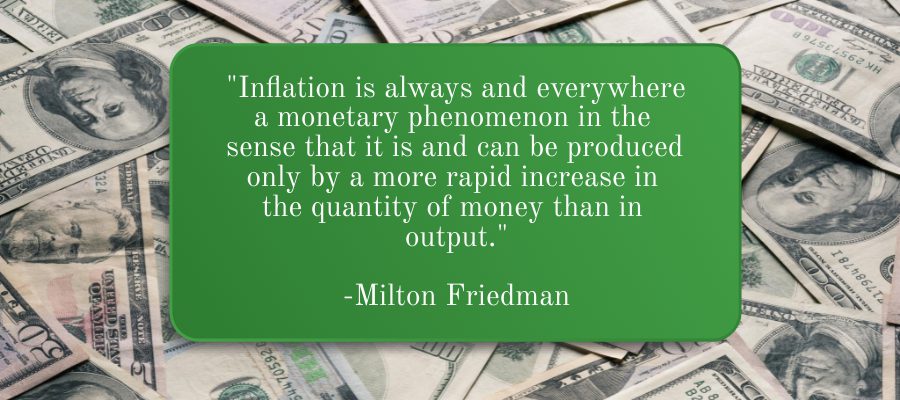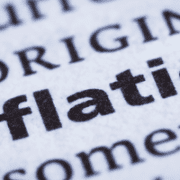Transitory Inflation and Useless Ingredients
To listen to the audio version of this article click here
Can you remember back to when you were two or three years old? Toddlers often think that there are little people inside the TV (or maybe this was only true when the TV was about as deep as it was wide—and maybe kids today don’t think this when looking at a 60-inch flatscreen…)
Anyways, it’s normal to grow out of this naïve view of television. No one believes it past the age of eight, much less into adulthood.
Purchasing Power and Intrinsicism
This is a simple instance of the philosophic concept of intrinsicism. To think of external characteristics as if they are inside or an integral part of an object. Actors are not inside the TV, nor are video production studios. Not even the content is inside the TV. The TV is nothing more than a medium to render video.
You may be wondering what this has to do with money. The connection is via the notion of purchasing power. Milton Friedman famously said that “inflation is everywhere and always a monetary phenomenon.”
This naturally leads people to think that whatever goods a dollar can purchase are intrinsic to the dollar itself. Indeed, if the quantity of dollars is the only cause of prices to rise, then the logical corollary is that the goods—and the people who produce them—are inside the dollar somehow.
Of course, no one thinks this explicitly. It’s just one of the contradictions of the Quantity Theory of Money that one must gloss over.
Living Inside the Dollar
The people who produce food, cars, and mobile phone service are not little elves (in the Santa Claus sense, not the Tolkien sense) living in the dollar which resides in your wallet. Once one is aware of this fact, then one can begin asking questions such as: what motivates these people, what would drive their cost up or down, and what inhibits them from producing and thus decreases supply, and hence cause genuine scarcity, and hence rising prices. And even questions such as: the deeper they go into debt, does this make them more, or less, aggressive to produce goods to dump on the market? And: if the interest rate ticks down, is this a greater incentive to borrow more to add production capacity?
The goods themselves are also not in the dollar. The dollar (or gold) is not a store of goods or the purchasing power to buy the goods. The value of the dollar is whatever those who produce goods will bid for it. And there are many, many factors that induce them to bid more, or to bid less.
What is the Cause of the Energy Crisis in the UK?
Now let’s look at the dire situation in the UK, with skyrocketing prices for energy that will soon impact food and other markets. If Friedman were correct, we could just point to growth in the quantity of pounds—M0 has grown about 8% in the last year. Then perhaps we would mutter “Cantillon Effect” or “leads and lags”, and chalk this up to inflation.
However, this doesn’t tell the full story. The way “daddy, there are people inside the TV” does not tell the full story of how Ted Lasso plays on your flatscreen. There is something else going on.
Regulation
The UK, like all the other de-industrializing countries, has enacted a bevy of anti-energy policies. One of them prohibits fracking to produce natural gas. Another policy has forced power plants and industry to switch from oil and coal, to natural gas. In other words, they decided that all natural gas used in the country shall be imported, and that a greater fraction of total energy consumption will be concentrated in natural gas.
This would not necessarily cause the price of energy to rise (though natural gas may be more expensive than oil or coal). However, it does make energy-intensive industries more vulnerable. In a free market, business managers seek to reduce risk by diversifying their supply chains. Feel-good diktats, like those in the UK, push all supply chains to depend increasingly (or solely) on one single point of failure. This forces managers to act against their better judgment, to concentrate their risks, and to hope that a disruptive event does not come along.
Lockdowns and Just-in-Time Supply Chains
Unfortunately, global lockdown came along.
Lockdown first shut down global shipping and logistics. Ships and containers were stranded in all the wrong places. Now that economies are reopening, a lot of demand that was held back has been released. However, manufacturing and distribution has long been in a trend to move towards just-in-time (the driver of this is monetary: the falling interest rate). Nobody has the capacity to produce and distribute all at once the goods that would have been purchased in a year. Much less after lockdown destroyed capacity at the margin. Unlockdown causes a kind of whiplash.
Nationalism and Trade Wars
Also, rising Nationalist policies all around the world in the wake of US President Trump’s “trade wars are good and easy to win” came along.
Nationalism and tariffs introduce more friction, and forces firms to secure sources of all manner of inputs—including natural gas—domestically. They are impelled to this approach, even if it’s less efficient and more expensive.
When you add up Anti-fracking + anti-coal-and-oil + trade war + lockdown whiplash = perfect storm for UK energy consumers.
Collateral Damage from the UK Energy Crisis
This storm is centered on the natural gas market. But its impact quickly spreads to other markets. For example, fertilizer is made from natural gas. Fertilizer manufacturing plants are shutting down, as the price farmers are willing to pay for fertilizer does not afford them a profit at the price they must pay for natural gas. It gets worse. A byproduct of natural gas fertilizer production is carbon dioxide. CO2 is used in other parts of the food chain, including meat production and distribution of frozen food.
Let’s drill into this one for a moment. When a commodity becomes scare, its price increases. The rising price causes the marginal consumer to substitute another good or stop consuming altogether. The price keeps rising, until enough marginal consumers stop, that demand matches supply.
The marginal consumer is farmers, meat packers, and frozen food distributors. Food producers are the marginal consumers!
As an aside—mostly, we want to focus on the monetary economics point, but this is too important to pass without comment—the stated premise of the environmental movement is to drive up the price of fossil fuels to reduce CO2 emissions (unrelated to CO2 used in food production). This is what that looks like in practice. If petrol goes up a few pennies per liter, that does not fundamentally transform the economy into a carbon-free utopia. Prices would have to go so high, that desperate impoverished people cannot afford energy. Energy would have to become so expensive, that people will be forced to abandon their cars, and suburban houses, and pile into small flats in the city and onto mass transit.
The UK has now had a warning shot across the bow.
Milton Friedman Was Wrong
Friedman was wrong. There is a great nonmonetary force that pushes prices up. We call it useless ingredients, when government regulators or taxinators force producers to add things that consumers do not value (and often do not even know are included). For example, forcing petrol refiners to add ethanol. Ethanol adds cost, but not value (indeed it reduces the vehicle’s mileage).
The situation with natural gas is another case of useless ingredients. We described several instances of it above, some pretty straightforward and some less obvious. If an electric plant is forced to switch from coal to natgas, then this may increase the price by, say, 1p per kilowatt hour or about 6%. The coal-natgas difference is a useless ingredient, that electricity customers must pay for whether they want it or not. The result is that this drives the marginal producer out of the market (typically those who are most vocally generous with such good-sounding proposals are not the marginal industries who are forced out of business).
The result is not that the pound sterling buys less than before. Natural gas may be more expensive due to increased use of labor and/or capital. But the currency is buying just as much as before, though now some of what it is buying is labor or capital wasted on non-value-adding steps.
People who don’t think about this useless ingredient in electricity, just call it inflation and mutter that “the purchasing power of the pound is going down”.
Increased Risk as a Useless Ingredient
Energy consumers were also forced to add a different kind of useless ingredient, one that is perhaps more abstract. They were forced to concentrate all their eggs in one natgas basket. This increased their risk, in a way that is made clear in this perfect storm. Increased risk is a useless ingredient.
And now, some prices are likely to skyrocket all out of proportion, including fertilizer and maybe food. The cause of this great foodflation is not monetary, but the added useless ingredient of supply chain risk due to green regulations, trade war, and lockdown whiplash.
Real People Suffer as a Result
We shall have to wait to see how the government responds, but we can be sure of one thing. They cannot create new natgas supplies quickly enough to provide the people with heat this winter, and feed them next summer. We assume that, even if they deregulate fracking tomorrow, this move would not bring new natgas to market in under a year. They might subsidize fertilizer manufacturers, but this would just force a different industry to do without natgas.
Prices of everything—from electricity, to goods manufactured in electricity-intensive processes, to food, to petrol and transportation—could rise out of reach of the average Briton.
What to do?
So what is the point? Why do we keep insisting that this is not a monetary phenomenon? Aside from the pursuit of truth, which is proper in itself, there are two reasons. One, on the practical level, this understanding will help you navigate the markets. For example, are these price hikes temporary or will they lead only to more and faster increases in prices? It depends, not on the quantity of pound sterling, but on whether the government repeals some of the bad laws that caused this problem, or whether it doubles down and forces everyone deeper into energy poverty.
The other is a point we cannot emphasize enough. The global regime of irredeemable currency is failing. The signs—such as negative interest rates—are myriad and obvious. If there is a chance to raise awareness, for the people to demand a solution, then it will only come if our criticisms of the system are on point. If we blame the currency for nonmonetary problems, we dilute the message, sow confusion, and we will only add to the noise level. And of course, if we want to help the UK resolve its natgas shortage, we would not serve them well by wrongly attributing it to the money supply.
Make sure to subscribe to our YouTube Channel to check out all our Media Appearances, Podcast Episodes and more!
Additional Resources for Earning Interest on Gold
If you’d like to learn more about how to earn interest on gold with Monetary Metals, check out the following resources:
In this paper we look at how conventional gold holdings stack up to Monetary Metals Investments, which offer a Yield on Gold, Paid in Gold®. We compare retail coins, vault storage, the popular ETF – GLD, and mining stocks against Monetary Metals’ True Gold Leases.













Any thoughts on the persistent oil backwardation?
Hi Jeffledin,
Thanks for reading and commenting. Oil backwardation isn’t something we track regularly. Gold and silver backwardation are more our thing. Was there something in particular you were wondering about?
I like your assessment, but it seems you have quite a bit of bias in your argument…
You state that the UK policies are “anti-energy” but really aren’t they just against certain sources of energy? Your characterization seems excessively negative because they would almost certainly call themselves pro-energy. They are pro-RENEWABLE and anti-CARBON. You don’t allow this distinction in your assessment.
But I get your frustration with regulation in general and I’m down for it.
Also, you claim and energy users were “forced to concentrate all their eggs in one natgas basket.” Is that really true? Forced? Or was that just the simple solution to their problem–and a very imprudent move at that. It seems more accurate to say they took the risky move of fragile, one dimensional supply chain and business as usual over a more complicated solution of pivoting their business.
I think a less antagonistic view would say the regulators are trying to diversify the energy marketplace by regulating the super cheap source. It’s obvious in your writing that you value diversity in the marketplace.
Furthermore, why do these governments add useless ingredients to the cheap energy sources in order to make it more expensive and disincentive people from using it, thereby trying to close the competitive gap between carbon and renewable energy? However, on the flip side, in the human energy sector (food) they actively subsidize the cheap food producers giving them a further competitive advantage over more responsible producers and thereby encouraging increasing levels of consolidation in big Ag.
And yet, you often write about how the trend of consolidation is driven by excessively competitive market where margins are thin and so debt fueled expansion and acquisition replaces true profits. According to that line of thought the food industry would be in a very dangerous place–engaging in desperate, profitless activities, (extreme levels of debt fueled consolidation and acquisition) WHILE taking incredible amounts of government aid AND generally speaking consuming their own assets (soil fertility and infrastructure–have you seen rural America recently?–disrepair is the term that comes to mind). I’d love to hear you write about that part of the economy!
Hello Joel, thanks for commenting! You raise some good points. I don’t want to speak for Keith but here are a few things I’d note in reply:
1. Ultimately, it is the market, composed of free individuals acting in their own self-interest, that is best suited to decide what kind of energy they choose to consume. By “best” I don’t mean “most efficient” or that there will be no errors or wrong decisions made by individuals. Rather that there is a moral principle at work here — that no man should force his decision on another.
2. Regulation is just that, force. Brute force. The rhetoric of regulation may be “diversifying the marketplace” or “saving mother earth” or “moving towards more sustainability.” And one may genuinely be in favor of some or all of those things on their own terms. But if you look behind the veil of good intentions and buzzwords, at the end of the day if a governing body shows partiality to one source of energy over another, and enacts regulation which penalizes firms (and individuals) who do not comply with it, that is the use of force. And it will cause consequences, many of which will be “unintended.”
Ironically, regulation like this doesn’t diversify anything, but does just the opposite. It helps to further ingrain the incumbents who excel at compliance (not necessarily energy production). The bigger you become, the more in favor of regulation you are because it is an effective way to keep the young and hungry entrepreneurs (the potentially disruptive competition) at bay. For more on how that works, google “regulatory capture.”
Regulation can never bring about market diversity, only the absence of regulation could do that.
Anyway, “force” here means that all companies who supply energy must now be in compliance with that regulation, or face penalty. The cost of that penalty may be so high that the marginal producer has to fold. Both of these consequences; a.) all firms must comply with the new regulation which favors one energy source over another and b) the cost of compliance will be too great to bear for some companies cause consolidation in the industry. The consolidation funnels capital and resources to a more concentrated energy source –the one regulators favor. If the supply of energy becomes this one-dimensional, even if consumers doth protest much, what other choice do they have? They could try and start an alternative energy company but alas, they’d have to comply with the same regulation that got us here in the first place!
3. I agree. The farming industry seems fertile ground for Keith’s analysis. I’ll forward your request and see if we can work it into a future post. If you have any analysis you’ve read, or experience you could draw from, please let us know!
I hope my replies above are helpful. And thanks again reading and commenting!
I think Friedman was wrong and also a sloppy. His sentence melds two statements.
(1) If money supply increases, without more goods being produced (insert more detail here), inflation will result
(2) This is a monetary phenomenon.
When he referred by implication to a decrease in Output, he may be taken to mean anything that reduces output, from man made (e.g. govt. intervention via regulation, etc) to natural disaster. Then the statement (1) holds true.
But when you add more detail for possible causes of a reduction in output, it is clear that this is not a purely monetary phenomenon, as you Keith point out. God save us please, from ‘brilliant’ intellectuals with all encompassing theories.
I think Friedman was wrong and also a sloppy. His sentence melds two statements.
(1) If money supply increases, without more goods being produced for the same total cost (insert more detail and conditions here), inflation will result
(2) This is a monetary phenomenon.
When he referred by implication to a decrease in Output, he may be taken to mean anything that reduces output, from man made (e.g. govt. intervention via regulation, etc) to natural disaster. Then the statement (1) holds true.
But when you add more detail for possible causes of a reduction in output, it is clear that this is not a purely monetary phenomenon, as you Keith point out. God save us please, from ‘brilliant’ intellectuals with their all encompassing theories.
Amen! :) Thanks for commenting Alana. Unfortunately, Friedman and the QTM are still the standard today, but we’re working to change that.
I enjoyed reading this. That said, I didn’t appreciate cantillon effects being thrown under the bus and grouped with modern monetary theory. You do well to point out that inflation does not increase prices directly, but rather that individuals in different circumstances with different information and motivations interact to create prices, but this is in complete agreement with the concept of the “cantillon effect,” which is in fact a famous description of how inflation of the money supply does not cause a uniform rise in prices because it effects specific individuals differently and the effects are not instantaneous. In the context you used it though, it was kind of an esoteric joke about people focusing too much on inflation and not enough on crippling state regulation, so it did kind of make sense, but still you basically explained cantillon effects early in the article and then disparaged them later.
All in all, your point that inflation is not as much to blame as crippling regulations is a point well taken and and underrated opinion in the world of bewildered socialists who fancy themselves “environmentalists.” And FYI, modern nuclear can be cleaner and safer than wind and solar as well as coal and natural gas, but it’s hard to produce. Guess why (… crippling regulations if you didn’t grt that)
Thanks for the comment Denny. We might quibble with Cantillon and his effects, but we appreciate your take!
Here’s a few more articles from the archives that explore the Quantity Theory of Money in greater depth and/or from different angles.
https://monetary-metals.com/how-to-maintain-a-bull-market-after-coronavirus-report-11-may/
https://monetary-metals.com/the-simon-ehrlich-bet-did-not-settle-the-question/
https://monetary-metals.com/monetary-paradigm-reset-report-5-august-2018/
Hi Keith. A very thought provoking article, as always!
At the risk of over-simplifying practically everything, it looks to me like the golden nugget of “truthiness” here is the bankers and politicians have agreed on a pact where, rather than throwing each other under the bus, they will instead collude to throw the fossil fuel industry under the bus while blaming Putin.
Best.
Thanks for reading and for commenting Brian!
No doubt the fossil fuel industry isn’t feeling a lot of love right now!
What you see as “uesless ingredients” in many cases someone else might see as “externalities” (that have been “free” up to now) being given a more appropriate “price”.
You seem so enamored with your rhetoric about these “ingredients” that you don’t even acknowledge that in some cases others don’t see them as useless. It sure seems like a blind spot.
In much if not most of your analyses you continue to give great insights. Thanks for that.
I concur. The ‘useless’ label conveys our anti-regulatory bias but that seems to cloud the logic with an emotion. In fact, products are always changing, adding and shedding ‘ingredients’. When I was a teenager a phone call was anonymous and private, both by law and because technology was unable to erode those natural states of a physical circuit. I am quite sure that such a phone call would cost you plenty in the modern world: to both encrypt and route the call.
There is another trend sabotaging supply chains and making end-user prices lose their traditional stability: the demise of the Money Market Funds. Recall the late Prof. Fekete’s fascination with the bills market (which over the centuries turned into the Money Market funds of 1979-2019). His claim is that this secondary market in commercial paper and the attendant due diligence done by brokers, bankers, and bill acceptance houses made certain bills circulate as monetizible assets (i.e sound banking reserves). In the mid ’80s, the Fed had to agonize over whether these ‘cash equivalent’ shares belonged in the money supply or not. In the ’00s, deposit insurers struggled with the same question. They eventually “added” the useless ingredient of FDIC coverage after Treasury found that these funds were systemically important and too big to fail, etc. This was apparently the straw that broke that camel’s back as the biggest player left the stage and converted to government paper funds rather than commercial paper.
If we reread those articles where Fekete discussed how ‘the discount rate’ operated in a regime of highly stable end-consumer prices (and thereby buffered against many supply or demand shocks while also deploying myriad vested observers and arbitrageurs of those supply chains), we get a hint of the depth of funding and market energy that helped us avoid direct experience of the price signals that ultimately coordinate the actions of market participants. When we were economics students, the classic supply/demand curves seemed like entirely theoretical constructs because NO price of a good (except perhaps gasoline) ever adjusted hour-by-hour or day-by-day, season-by-season, or year-by-year in any way which suggested it was a communication channel. The full story of all the intermediate bills and futures contracts whose prices WERE swinging around minute-by-minute was never drawn for us.
Exit the bills market and that buffering of the communication channel is now gone.
What we see in goods pricing is that our communication network between supplier and consumer is no longer
buffered, automated, and flush with discounted paper instruments. If a signal need be sent, then a consumer must raise or lower his bid, so the suppliers can (with full lag times) match the new equilibrium point.
Plenty of price action being diagnosed as ‘inflation’ falls under this ‘brittle supply chain finance’ category.
The Greensill debacle is typical of the end stage condition of a dying market, just as Evergrande is this year.
Thank you Gregory for your comment. We are working to bring back the gold bills market, but in gold of course. “Brittle” is an apt word for the system we have today. Your comments made me remember this old but still relevant article: https://monetary-metals.com/the-credit-gradient/
Thanks again for reading and sharing your thoughts!